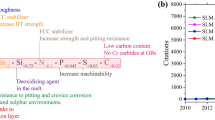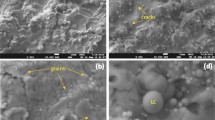Abstract
Achieving a plasma sprayed cast iron coating containing graphite requires stringent control on spray parameters that synergistically influence the coating properties and thus the performance. The microstructure of cast iron splats greatly depends on spray parameters such as substrate temperature, chamber pressure, and spray distance. This paper presents the effect of chamber pressure on the splat microstructure, including oxides and graphite. At low chamber pressures, most splats exhibit a disk shape with high flattening ratios, whereas star-shaped splats extensively appear at high chamber pressures. Spraying at high chamber pressures causes the formation of pores and thick oxide zones at the splat/substrate interface, mainly due to the atmospheric gases, which are responsible for a decrease in splat adhesion. Spraying in Ar atmosphere reduces the splat oxidation due to a decrease in the oxygen partial pressure. Small deformed substrate ridges are observed adjacent to the periphery of splats sprayed at low chamber pressures whereas no ridges are detected at high chamber pressures. Ridge formation generates a kind of mechanical bond, which increases the adhesive strength. Since the molten droplets impinge with high velocity and thus high flattening ratio at low chamber pressures, the solidification rate becomes faster, and graphite formation is resultantly hindered.
Similar content being viewed by others
References
M. Ebisawa, T. Hara, T. Hayashi, and H. Ushio: “Production Process of Metal Matrix Composite (MMC) Engine Block,” SAE Tech Paper Series, 910835, 1991.
K. Funatani, K. Kurosawa, P.A. Fabiyi, and M.F. Puz: “Improved Engine Performance via Use of Nickel Ceramic Composite Coatings,” SAE Tech. Paper Series, 940852, 1994.
G. Wuest, G. Barbezat, and S. Keller: “The Key Advantages of the Plasma-Powder Spray Process for the Thermal Spray Coating of Cylinder Bores in Automotive Industry.” SAE Tech. Paper Series, 970016, 1997.
K. Murakami, T. Okamoto, Y. Miyamoto, and S. Nakazono: “Rapid Solidification and Self-annealing of Fe-C-Si Alloys by Low Pressure Plasma Spraying,” Mater. Eng. Sci., A117, 1989, pp. 207–14.
R.C. Dykhuizen: “Review of Impact and Solidification of Molten Thermal Spray Droplets,” J. Therm Spray Technol., 1994, 3(4), pp. 351–61.
M.F. Morks, Y. Tsunekawa, M. Okumiya, and M.A. Shoeib: “Splat Morphology and Microstructure of Plasma Sprayed Cast Iron With Different Preheat Substrate Temperature,” J. Thermal Spray Technol., 2002, 11(2), pp. 226–32.
S. Sodeoka, M. Suzuki, and T. Inoue: “Control of Plasma Sprayed Particle Temperature and Velocity by Chamber Pressure” in Proc. Int. Thermal Spray Conf. ASM International, Materials Park, OH, 2001, pp. 737–41.
S. Fantassi, M. Vardelle, A. Vardelle, and P. Fauchais: “Influence of the Velocity of Plasma Sprayed Particles on Splat Formation,” J. Therm. Spray Technol., 1993, 2(4), pp. 379–84.
R. McPherson: “The Relationship Between the Mechanism of Formation, Microstructure and Properties of Plasma Sprayed Coatings,” Thin Solid Films, 1981, 83, pp. 297–310.
V. Palka, M. Brezovsky, J. Ivan, and J. Sith: “Identification of Oxides in Plasma Sprayed APS Coating of the NiCrAIY Type” in Thermal Spray: International Advances in Coatings Technology, C.C. Berndt, ed., ASM International, Materials Park, OH, 1992, pp. 537–42.
V.V. Sobolev and J.M. Guilemany: “Flattening of Droplets and Formation of Splats in Thermal Spraying: A Review of Recent Work, Part I,” J. Therm. Spray Technol., 1999, 8(1), pp. 87–101.
O.P. Solonenko: “The Fundamental Thermophysical Problems of Plasma-Spraying” in Thermal Spray: International Advances in Coatings Technology, C.C. Berndt, ed., ASM International, Materials Park, OH, 1992, pp. 787–92.
J.M. Houben: “Future Development in Thermal Spraying” in Proc. 2nd Natl. Conf. Thermal Spray, Long Beach, CA, ASM International, Materials Park, OH, 1985, pp. 1–12.
M.P. Planche, O. Betoule, J.F. Coudert, A. Grimaud et al.: “Performance Characteristics of a Low Velocity Plasma Spray Torch” in Thermal Spray Coatings: Research, Design and Applications, C.C. Berndt, ed., ASM International, Materials Park, OH, 1993, pp. 81–87.
V.V. Sobolev and J.M. Guilemany: “Influence of Wetting and Surface Effects on Splat Formation During Thermal Spraying,” Mater. Lett., 1998, 37, pp. 132–37.
E.A. Brandes and G.B. Brook: in Smithells Metals Reference Book, 7th ed., Butterworth-Heinemann, Oxford, UK, 1992.
G.H. Geiger and D.R. Poirier: in Transport Phenomena in Metallurgy, Addison-Wesley, Reading, MA, 1973, pp. 329–60.
Author information
Authors and Affiliations
Rights and permissions
About this article
Cite this article
Morks, M.F., Tsunekawa, Y., Okumiya, M. et al. Splat microstructure of plasma sprayed cast iron with different chamber pressures. J Therm Spray Tech 12, 282–289 (2003). https://doi.org/10.1361/105996303770348393
Received:
Revised:
Issue Date:
DOI: https://doi.org/10.1361/105996303770348393




